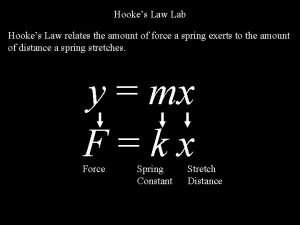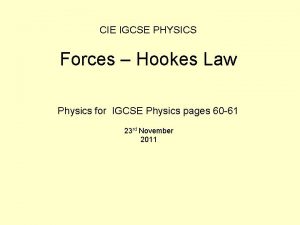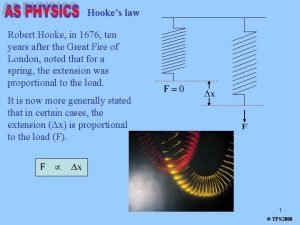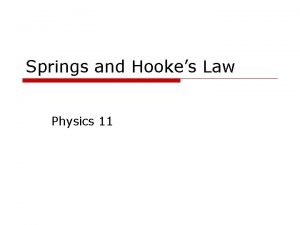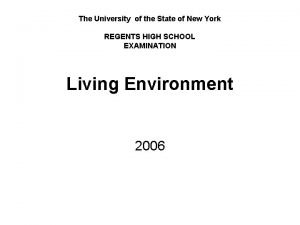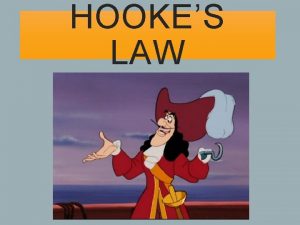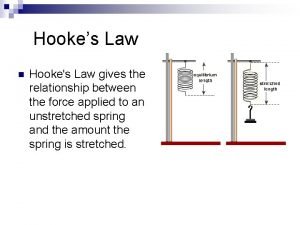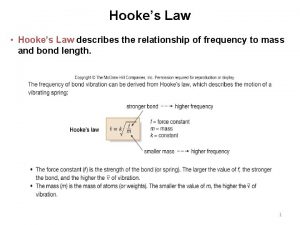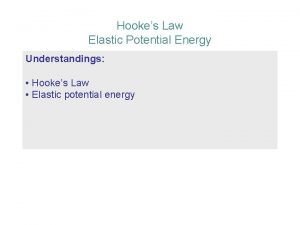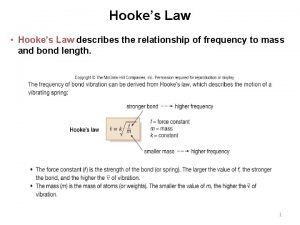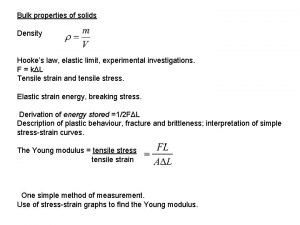Hookes Law Hookes Law In 1660 a scientist























- Slides: 23

Hooke’s Law ?


Hooke’s Law In 1660, a scientist called Robert Hooke discovered a law for elastic materials. He was trying to improve the type of clocks that were used on ships (pendulum clocks) and theorized that a spring would work better on a pitching ship.

We are familiar with spring scales Not used in industry, b/c can’t be calibrated accurately and can become overstretched

Hooke's Law, elasticity • If a material returns to its original size and shape when you remove the forces stretching or deforming it (reversible deformation), we say that the material is demonstrating elastic behaviour. • If you apply too big a force a material will lose its elasticity. • Hooke discovered that the amount a spring stretches is proportional to the amount of force applied to it. This means if you double the force its extension will double, if you triple the force the extension will triple and so on.





The elastic limit can be seen on the graph. This is where it stops obeying Hookes law.


You can write Hooke's law as an equation: F = k∆x Where: • F is the applied force (in newtons, N), • x is the extension (in metres, m) and • k is the spring constant (in N/m). • ∆x = stretched length – original length.

Hooke's H______ Law: The compression or elongation x of an equilibrium ideal spring from its e________ position (x = 0) directly proportional is d______________to the applied force Fs. Fs = kx compression: stretching or elongation: x=0 x x Fs Fs More F more s______ or c_________. stretch compression

Hooke's Law is often written: Fs = - kx This is because it also describes the force that the itself object s spring _______ exerts on an o______ that is attached to it. The negative sign indicates that the direction of opposite the spring force is always o _______ to the displacement of the object

A weight of 8. 7 N is attached to a spring that has a spring constant of 190 N/m. How much will the spring stretch?

Ex. A weight of 8. 7 N is attached to a spring that has a spring constant of 190 N/m. How much will the spring stretch? w/ weight w/o weight Given: Fs = 8. 7 N k= 190 N/m x Unknown: x =? Equation: Fs = kx 8. 7 N = (190 N/m) x x = 4. 6 x 10 -2 m 8. 7 N

Fs = kx Ex: A force of 5. 0 N causes t 0. 015 m. How far will it stretch if the force is 10 N? he spring to stretch Fs direct 10 5 2 (0. 015 m) = 0. 030 m . 015 ? x What quantity does the slope represent? slope = Dy/Dx = Fs/x the spring constant, k. The slope represents ________________ k

Ex. Comparing two springs that stretch different amounts. spring B Fs spring A Applying the same force F to both springs x. B Which spring stretches more? Which is stiffer? B x. A x A greater larger stiffer spring _____ slope _____ k

Elastic ______ PE - the energy stored in a spring when work is done on it to stretch or compress it PEs = (½)kx 2 Ex. A spring with a spring constant of 370 N/m is stretched a distance 6. 4 x 10 -2 m. How much elastic PE will be stored in the spring? PEs = (½)kx 2 = (0. 5)( 370 N/m)(6. 4 x 10 -2 m)2 = 0. 76 (N/m)(m 2) = 0. 76 Nm = 0. 76 J How much work was done to stretch the spring by this amount? W = DPE = 0. 76 J

Hold on a minute, K? Spring Constant? ! • The spring constant measures how stiff the spring is. • The larger the spring constant the stiffer the spring. • You may be able to see this by looking at the graphs below: k is measured in units of newtons per metre (Nm -1).

• A spring is 0. 38 m long. When it is pulled by a force of 2. 0 N, it stretches to 0. 42 m. What is the spring constant? Assume the spring behaves elastically. Extension, ∆x = Stretched length – Original length =. 0. 42 m – 0. 38 m = 0. 04 m F=k∆x 2. 0 N = k x 0. 04 m So, k = 2. 0 N 0. 04 m = 50 N m-1

Elastic behaviour – Car Safety • Elastic behaviour is very important in car safety, as car seatbelts are made from elastic materials. However, after a crash they must be replaced as they will go past their elastic limit. • Why have seat belts that are elastic? • Why not just have very rigid seatbelts that would keep you firmly in place? • The reason for this, is that it would be very dangerous and cause large injuries. This is because it would slow your body down too quickly. The quicker a collision, the bigger the force that is produced.

Key Definitions • Hooke’s Law = The amount a spring stretches is proportional to the amount of force applied to it. • The spring constant measures how stiff the spring is. The larger the spring constant the stiffer the spring. • A Diagram to show Hooke’s Law F=k∆x
 Stress strain curve for ductile and brittle material
Stress strain curve for ductile and brittle material Hooke's law formula
Hooke's law formula Graph of force against extension
Graph of force against extension Hooke's law
Hooke's law Hookes law
Hookes law Hooke's law states that
Hooke's law states that Jacobean age
Jacobean age The renaissance 1485-1660
The renaissance 1485-1660 Renaissance (1537 ad - 1660 ad)
Renaissance (1537 ad - 1660 ad) Restoration period 1660 to 1700
Restoration period 1660 to 1700 Daniel defoe (1660-1731)
Daniel defoe (1660-1731) Daniel defoe was born in 1660 into a family of dissenters
Daniel defoe was born in 1660 into a family of dissenters 1660 time period
1660 time period Mikroskop 1660
Mikroskop 1660 Mikroskop 1660
Mikroskop 1660 French word for rebirth
French word for rebirth The english renaissance 1485 to 1660
The english renaissance 1485 to 1660 Food scientists measure food energy in
Food scientists measure food energy in Data scientist ausbildung wien
Data scientist ausbildung wien Things a computer scientist rarely talks about
Things a computer scientist rarely talks about The diagram below shows how a coverslip should be lowered
The diagram below shows how a coverslip should be lowered Data science mindmap
Data science mindmap Far side rocket scientist
Far side rocket scientist Staff scientist nih
Staff scientist nih

